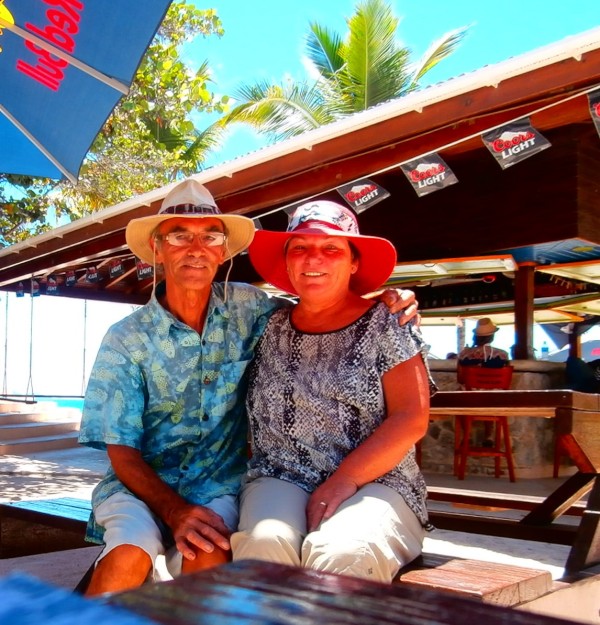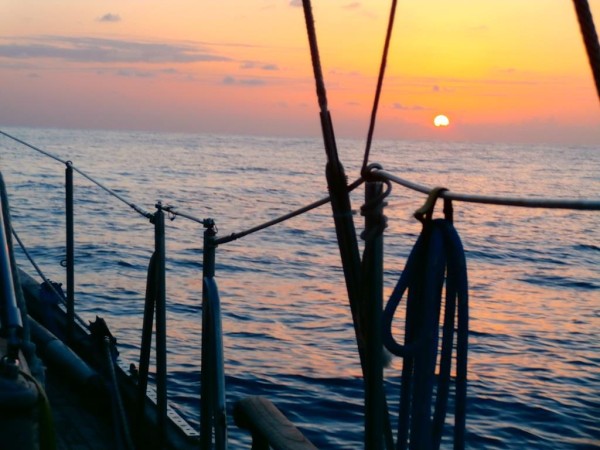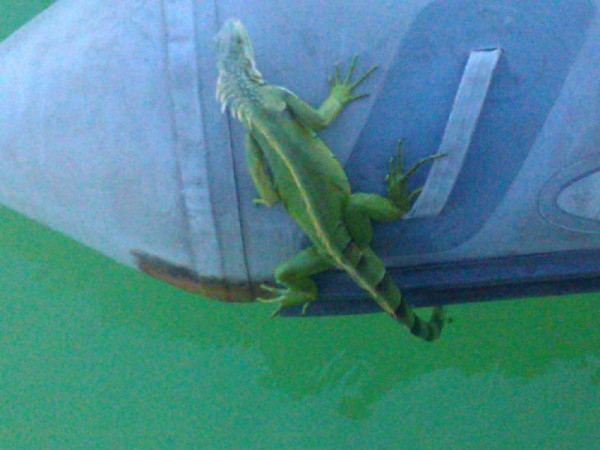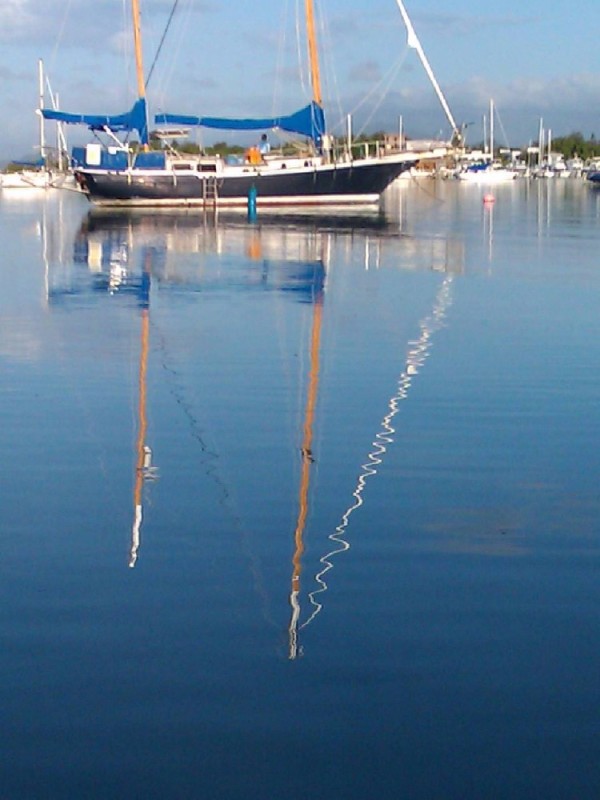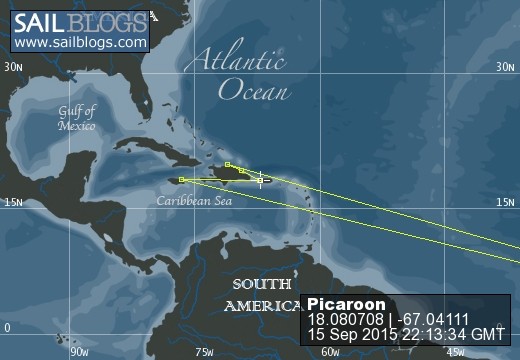
Sailors to seadogs
Jackie & Colins' adventures on the high seas.
09 April 2017
03 April 2017
03 April 2017
29 July 2016
19 July 2016
21 June 2016
20 May 2016
13 March 2016
27 February 2016
27 February 2016
18 November 2015
12 November 2015
27 September 2015
15 September 2015 | Puerto Real Marina
07 September 2015
30 August 2015
30 August 2015
28 July 2015
26 July 2015 | Ile a Vache, Haiti
18 July 2015 | Ila a Vache Haiti
Hemp and hearts of Oak
04 September 2012
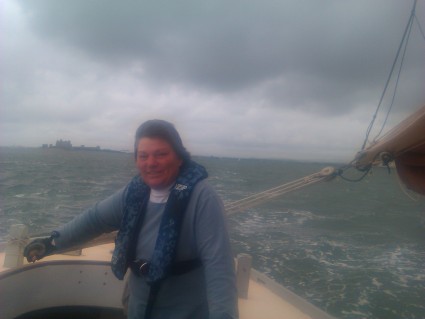
Sailing on a 100 year old boat is not very different to sailing on a modern vessel, your still using the wind to power the sails, but there the similarities cease. There are no winches on Hearts of Oak, and all the lines are rigged with old fashioned hemp. They're stiff and all the same colour. This boat is a gaff rigged cutter, I think. That is it has a big sail at the front a smaller sail between that and the mast then a big mainsail hung on a big wooden spar. This has lines that raise the throat and the peak, that is the bit that closest to the mast being the throat and the bit that's towards the back, aft end, being the peak. Hauling this heavy lump of wood up in the air is not as difficult as at first it would appear as it runs through a series of block and tackle that make the job a bit easier. The problem comes when trying to figure out which line to pull on. Forward of the mast is a series of pins where the halyards are secured, there's six pins in all, I think. Two of these are for the main sail,, two for the staysail and jib, and two for the topping lifts. All of these ropes, sorry, lines look exactly the same. The idea is that the halyards will always be in certain positions on our row of pins, this will make it easy for each of the crew, which will be different on every voyage, to haul up or down the sail plan. Unfortunately no-one is exactly sure what this order is. The two outer pins should be the mainsail throat and peak, the next two, the staysail and jib, and the middle two the topping lift. But that is only the concept, in practice it may be different.
One of our members of the crew has worked out that if we have endless lines on the halyarrds the this will enable us to be able to work the sails from inside the boat and never have to go on deck, so ensuring optium safety for the crew. Unfortunately this has only served to add confusion to the rigging of our beloved Hearts of Oak.
In theory it's a great idea, but in practice it doesn't work.
Anyway, we love sailing in this 100 year old boat but most times we've been out on her it's been in very light airs, and the sailing has been frustrating. Today was different, today we had a force 4 gusting to 6 and here was a good chance to try her out in good sailing conditions. As you can see from the video she can certainly move given the right conditions. Our skipper for the day decided against putting up the jib which made her a bit heavy on the helm. We put in a couple of reefs in the main prior to casting off and found her moving along at a very reasonable pace of maybe 6 knots. This would be the liveliest conditions she had ever been sailed in and although we had moments of panic we did have a glorious few hours sail. I made a discovery about the topping lifts, there's two of them, where you have to let the leward side out and tension the windward side each time you tack or jibe. Chris our skipper didn't think we should mess with them but I was determined to suss out why we always had a bad sail shape and found that we had two topping lifts that had to be adjusted on each tack or jybe. Once I got this sorted the sails looked much better, without being fouled by the lines for the topping lift and she sailed even better. But we should have put the jib sail up. You see although Chris is a much more experienced sailor than any of todays' crew he's a bit too cautious and for some reason he doesn't like putting up the jib which has to be hauled out along a wooden bow sprit with a very simple bit of rigging, just a hoop of metal that slides along a pole, basically. This means being on the foredeck and with no safety rails on this old boat, this gives Chris the willies. He's also not a big fan of R.I.B.s which is why she's kept on a drying mooring. We have to be on the boat two hours before high tide and back two hours after high tide.
On this daysail I'm afraid Chris just missed the deadline to be back and we grounded the boat about twenty feet from the mooring bouy, it was one of those days. Poor Chris I'm sure he was so embarrassed about this but we just waited for the tide to drop and hooked her back on.
In a couple of weeks we will have to haul her out of the water for her winter layup. There's quite a few jobs to be done, but the season has been so short here in Morcambe bay, and the weather has not been the kindest of summers. But it's been an education getting to sail such a lovely old boat.
One of our members of the crew has worked out that if we have endless lines on the halyarrds the this will enable us to be able to work the sails from inside the boat and never have to go on deck, so ensuring optium safety for the crew. Unfortunately this has only served to add confusion to the rigging of our beloved Hearts of Oak.
In theory it's a great idea, but in practice it doesn't work.
Anyway, we love sailing in this 100 year old boat but most times we've been out on her it's been in very light airs, and the sailing has been frustrating. Today was different, today we had a force 4 gusting to 6 and here was a good chance to try her out in good sailing conditions. As you can see from the video she can certainly move given the right conditions. Our skipper for the day decided against putting up the jib which made her a bit heavy on the helm. We put in a couple of reefs in the main prior to casting off and found her moving along at a very reasonable pace of maybe 6 knots. This would be the liveliest conditions she had ever been sailed in and although we had moments of panic we did have a glorious few hours sail. I made a discovery about the topping lifts, there's two of them, where you have to let the leward side out and tension the windward side each time you tack or jibe. Chris our skipper didn't think we should mess with them but I was determined to suss out why we always had a bad sail shape and found that we had two topping lifts that had to be adjusted on each tack or jybe. Once I got this sorted the sails looked much better, without being fouled by the lines for the topping lift and she sailed even better. But we should have put the jib sail up. You see although Chris is a much more experienced sailor than any of todays' crew he's a bit too cautious and for some reason he doesn't like putting up the jib which has to be hauled out along a wooden bow sprit with a very simple bit of rigging, just a hoop of metal that slides along a pole, basically. This means being on the foredeck and with no safety rails on this old boat, this gives Chris the willies. He's also not a big fan of R.I.B.s which is why she's kept on a drying mooring. We have to be on the boat two hours before high tide and back two hours after high tide.
On this daysail I'm afraid Chris just missed the deadline to be back and we grounded the boat about twenty feet from the mooring bouy, it was one of those days. Poor Chris I'm sure he was so embarrassed about this but we just waited for the tide to drop and hooked her back on.
In a couple of weeks we will have to haul her out of the water for her winter layup. There's quite a few jobs to be done, but the season has been so short here in Morcambe bay, and the weather has not been the kindest of summers. But it's been an education getting to sail such a lovely old boat.
Comments
| Vessel Name: | Picaroon |
| Vessel Make/Model: | Hardin Sea Wolf (Formosa 41) |
| Hailing Port: | Luperon Dominican Republic |
| Crew: | Jackie and Colin Williams |
| About: | We had never sailed until September 09 when we went on a RYA Start yachting course in Largs in Scotland. We have this plan to learn how to sail a 36ft boat around the Caribbean, in about 2 years time. 2011/12 now updated to August 2013 |
| Extra: |
Sailors to Seadogs
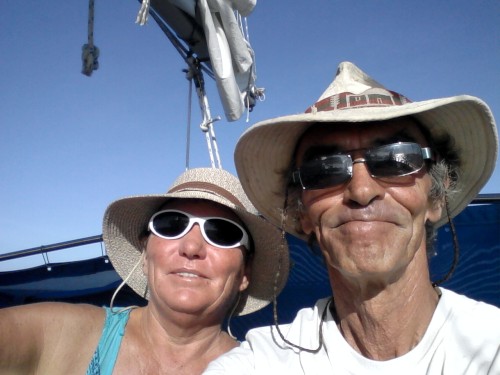
Who: Jackie and Colin Williams
Port: Luperon Dominican Republic

